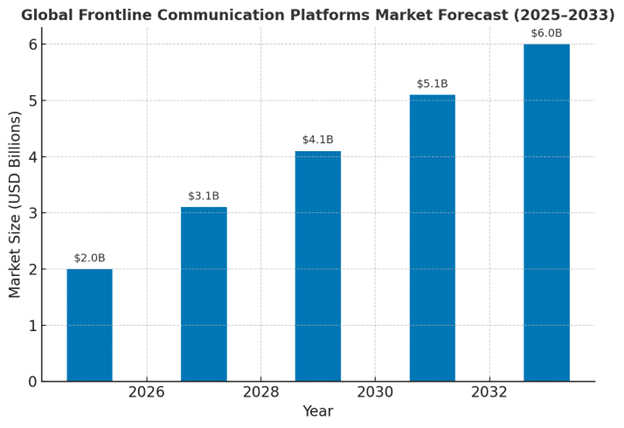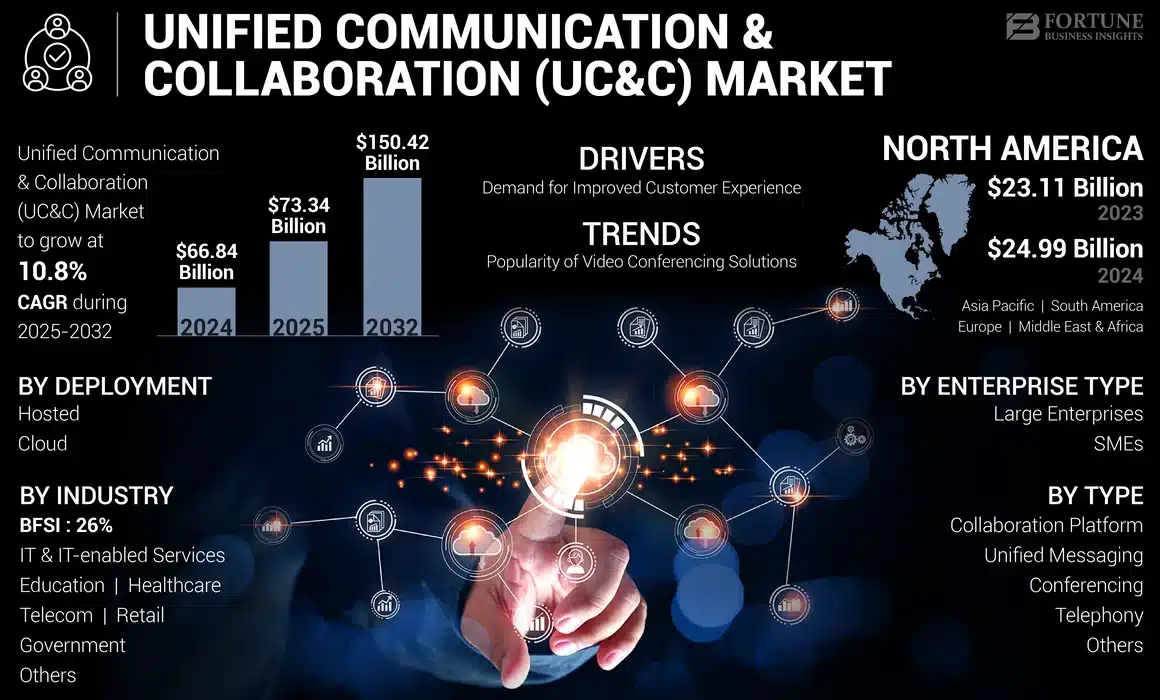Frontline workers represent more than 2.7 billion people worldwide, or nearly 80 percent of the global workforce. For many years, these workers had limited access to modern communication technology. In 2025, that is changing.
The most effective communication tools for frontline workers in 2025 are mobile-first, easy to use, and designed for non-desk environments. They combine real-time messaging, safety alerts, scheduling, and engagement features. This makes it possible for frontline teams to stay connected, informed, and supported at work.
The most effective communication tools for frontline workers in 2025 are mobile-first, real-time platforms that combine messaging, translation, safety alerts, and HR integration. Global spending on communication platforms is set to more than double by 2032, showing strong growth. Weavix stands out by offering not just software but also rugged Smart Radios and instant safety features designed for industrial environments.
1. Weavix – The All-in-One Frontline Communication Hub
Weavix is built specifically for frontline workers. It provides a single hub for communication, safety, and workforce engagement. Unlike traditional office tools, Weavix combines software and hardware to meet the unique needs of industrial environments.
Key features include:
- Push-to-talk, voice, text, photo, and video messaging
- AI-powered translation and transcription across multiple languages
- Rugged Walt Smart Radios designed for industrial worksites
- Instant safety alerts and emergency notifications
- Group, channel, and one-to-one communication with accountability
- Integration with communications and workforce systems
Best for: Manufacturing, energy, logistics, and other sectors where speed, clarity, and safety are essential.
Data point: Companies that invest in dedicated frontline communication platforms report 22% higher productivity compared to those relying on office tools.
>>>> Learn how the Walt Smart Radio System sets the standard for modern industrial communication.
2. Workvivo – Focused on Community and Engagement
Workvivo provides frontline teams with communication and engagement in one platform. It supports real-time chat, video calls, live streaming, and interactive posts. Its strength is building a sense of belonging and inclusivity across distributed teams.
3. Beekeeper – Shift Communication for Deskless Teams
Beekeeper is designed for industries like hospitality, logistics, and retail. The platform centralizes shift updates, HR announcements, and employee feedback. With multilingual support and offline functionality, it keeps non-desk employees informed and connected.
Data point: Research shows that 60% of frontline employees miss critical updates when mobile communication tools are not available.
4. HubEngage – Messaging Across Multiple Channels
HubEngage integrates push notifications, SMS, WhatsApp, Teams, Slack, email, and even digital signage. The platform makes it easy to reach frontline workers through the channel that fits best. It also includes analytics to measure engagement and morale.
5. YOOBIC – Training and Communication in One Platform
YOOBIC blends real-time communication with microlearning and task management. Managers can assign tasks, deliver training modules, and track completion from a single mobile-first platform. This makes it well suited for organizations that prioritize continuous learning.
6. Microsoft Teams and Slack – Office Collaboration Tools Extended to the Frontline
Teams and Slack remain popular choices because of their channels, integrations, and mobile apps. They are not built specifically for frontline use, but many organizations adopt them to provide consistent communication between desk and non-desk staff
Growth of Frontline Communication Platforms
Over the past 20 years, frontline communication platforms have evolved from almost non-existent into a fast-growing global market. In 2010, enterprise social software was valued at less than $700 million worldwide. By 2024, the global unified communications and collaboration market reached $66.8 billion, and it is projected to surpass $150 billion by 2032 with a CAGR of about 11%.
The U.S. market is expanding even faster. In 2024, unified communications tools in the U.S. represented about $36 billion in revenue, with forecasts showing growth to $144 billion by 2033. This reflects a CAGR of nearly 15%, fueled by rapid adoption of mobile-first platforms across frontline-heavy industries like energy, logistics, and manufacturing.
Within this broader trend, the niche for frontline worker communication platforms is also rising sharply. The global frontline communication software market is projected to grow from $2 billion in 2025 to more than $6 billion by 2033. This shows that companies are investing heavily to close the gap for non-desk employees.

Global frontline communication platforms market forecast (2025–2033). The market is expected to grow from $2 billion in 2025 to $6 billion in 2033, reflecting nearly threefold growth in less than a decade. Source: Verified Market Research, Verified Market Reports, and Transparency Market Research (Employee Communications / Frontline Worker Communication Platforms Market Outlook, 2024–2033).
| Platform | Real-Time Voice | Text, Photo, Video Messaging | Translation | Safety Alerts | Offline Access | Scheduling / HR Integration | Hardware Support |
|---|---|---|---|---|---|---|---|
| Weavix | Yes | Yes | AI-powered | Instant alerts | Via Smart Radios | HRIS and workforce systems | Rugged Smart Radios |
| Workvivo | Yes (chat, calls) | Yes | 90+ languages | Not primary focus | Mobile app | HR integrations | Software only |
| Beekeeper | Yes (chat) | Yes | Multilingual | Limited | Offline access | Shift & HR updates | Software only |
| HubEngage | No voice | Yes | Multi-channel | Not core | Mobile/web | HR & analytics | Software only |
| YOOBIC | Yes | Yes | Limited | Not core | Mobile app | Task & training modules | Software only |
| Microsoft Teams | Yes | Yes | Limited | Not core | Mobile app | Office & HR integrations | Software only |
| Slack | Yes (calls) | Yes | Limited | Not core | Mobile app | App integrations | Software only |
Figure: Global Unified Communication & Collaboration (UC&C) market size in 2024 and forecast. The worldwide UC&C market was $66.8 billion in 2024 and is projected to reach $150.4 billion by 2032 (≈10.8% CAGR). Major growth drivers include demand for integrated collaboration tools and video conferencing, with North America accounting for ~37% of the market. (source: Fortune Insights).
Key Features to Look For in 2025
When evaluating frontline communication platforms in 2025, several features stand out:
- Mobile-first design with iOS and Android apps
- Offline access to critical updates
- Translation and accessibility features for diverse workforces
- Analytics and reporting for managers
- Integration with scheduling and workforce systems
Choosing the Right Tool
The right communication tool depends on the size of the workforce, the industry, and the specific needs of the organization. Companies in industrial or high-risk environments benefit from platforms like Weavix that prioritize safety and emergency alerts. Organizations in hospitality or retail may prefer solutions like Beekeeper or Crew for scheduling and shift updates.
In 2025, the most effective communication tools for frontline workers unify real-time messaging, safety features, and employee engagement in one system. Weavix stands out by offering a complete solution designed specifically for frontline workers.
Frequently Asked Questions about Frontline Communication Tools in 2025
What is the best communication tool for frontline workers in 2025?
The best tool depends on the needs of the organization, but Weavix stands out because it combines real-time messaging, AI-powered translation, rugged Smart Radios, and instant safety alerts. It is purpose-built for industries like manufacturing, energy, and logistics.
Why are mobile-first platforms important for frontline teams?
Mobile-first platforms allow frontline workers to access communication tools on iOS and Android devices, even when they are away from a desk. This ensures messages, safety alerts, and updates reach every worker in real time.
Do frontline communication tools support multiple languages?
Yes. Most leading tools now include translation features. Weavix uses AI-powered translation and transcription to support teams that speak different languages on the same worksite.
Which industries benefit most from frontline communication platforms?
Industries such as manufacturing, construction, energy, logistics, and retail benefit most. These sectors have large non-desk workforces that require fast, reliable communication to stay safe and productive.
How do these tools integrate with HR and scheduling systems?
Many frontline communication platforms connect with HR software and scheduling systems. This reduces administrative work and ensures employees get updates on shifts, compliance, and payroll in the same place they receive other communications.



